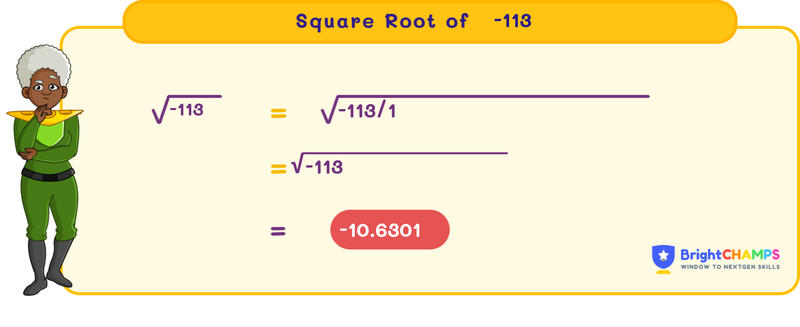


 109 Learners
109 LearnersLast updated on May 26th, 2025

Square Root of -113

If a number is multiplied by the same number, the result is a square. The inverse of the square is a square root. The square root is used in the field of complex numbers, electrical engineering, etc. Here, we will discuss the square root of -113.
What is the Square Root of -113?
The square root is the inverse of the square of the number. Since -113 is negative, its square root is not a real number. The square root of -113 is expressed in terms of imaginary numbers. In the radical form, it is expressed as √-113, whereas in exponential form, it is (-113)^(1/2). In terms of imaginary numbers, it is expressed as √113 * i, which is an imaginary number because it involves the imaginary unit i, where i = √-1.
Finding the Square Root of -113
For negative numbers, the square root involves imaginary numbers. The concept of imaginary numbers is used to express square roots of negative numbers. Let us now learn how to find the square root of -113 using this concept:
- Imaginary unit method
- Approximation method for √113
Square Root of -113 by Imaginary Unit Method
The imaginary unit is used to express the square roots of negative numbers. The imaginary unit is denoted by i, where i = √-1.
Step 1: Express -113 as the product of 113 and -1: -113 = 113 × (-1)
Step 2: Use the property of square roots to separate: √-113 = √(113 × -1) = √113 × √-1
Step 3: Replace √-1 with i: √-113 = √113 × i Thus, the square root of -113 is √113 * i.
Square Root of -113 by Approximation Method for √113
Approximation method can be used to estimate the square root of the positive part, 113.
Step 1: Find the closest perfect squares around 113. The closest perfect squares are 100 (10^2) and 121 (11^2). So, √113 falls between 10 and 11.
Step 2: Linear approximation formula: (Given number - smaller perfect square) ÷ (larger perfect square - smaller perfect square) For 113: (113 - 100) ÷ (121 - 100) = 13 ÷ 21 ≈ 0.619
Step 3: Add this to the smaller root: 10 + 0.619 ≈ 10.619 Therefore, √113 ≈ 10.619. Thus, the square root of -113 is approximately 10.619i.

Common Mistakes and How to Avoid Them in the Square Root of -113
Students often make mistakes when dealing with square roots of negative numbers. This includes ignoring the imaginary unit, misapplying properties of square roots, and confusing real and imaginary results. Let's explore these mistakes in detail.

Square Root of -113 Examples

Problem 1
Can you help Max find the absolute value of the square root of -113?

The absolute value is approximately 10.619.
Explanation
The absolute value of a complex number a + bi is √(a^2 + b^2). Here, for √-113 = 10.619i, the absolute value is |10.619i| = √(0^2 + 10.619^2) = 10.619.

Problem 2
A circuit has an impedance of √-113 ohms. What is the magnitude of this impedance?

The magnitude of the impedance is approximately 10.619 ohms.
Explanation
Impedance in complex form is expressed as √-113 = 10.619i. The magnitude is the absolute value, which is 10.619.

Problem 3
Calculate 2 times the square root of -113.

Approximately 21.238i.
Explanation
First, find the square root of -113, which is approximately 10.619i. Then multiply by 2: 2 × 10.619i = 21.238i.

Problem 4
What will be the square root of (-113 + 25)?

The square root is ±9.434.
Explanation
First, find the sum: -113 + 25 = -88. Then find the square root of -88: √-88 = √88 * i. Approximating √88 ≈ 9.434, so the result is ±9.434i.

Problem 5
Find the complex conjugate of the square root of -113.

The complex conjugate is -10.619i.
Explanation
For a complex number a + bi, the complex conjugate is a - bi. Here, the square root of -113 is 0 + 10.619i, so the conjugate is 0 - 10.619i.


FAQ on Square Root of -113
1.What is √-113 in its simplest form?
2.What is the value of i in complex numbers?
3.How is the magnitude of a complex number calculated?
4.Is -113 a complex number?
5.Can a real number have an imaginary square root?
Important Glossaries for the Square Root of -113
- Square root: The inverse of squaring a number. For negative numbers, involves imaginary numbers.
- Imaginary unit: Denoted by i, it is the square root of -1, used to express square roots of negative numbers.
- Complex number: A number of the form a + bi, where a and b are real numbers, and i is the imaginary unit.
- Magnitude: The absolute value of a complex number, calculated as √(a^2 + b^2).
- Complex conjugate: For a complex number a + bi, its conjugate is a - bi, reflecting it across the real axis.
Explore More algebra
 Previous to Square Root of -113
Previous to Square Root of -113


Jaskaran Singh Saluja
About the Author
Jaskaran Singh Saluja is a math wizard with nearly three years of experience as a math teacher. His expertise is in algebra, so he can make algebra classes interesting by turning tricky equations into simple puzzles.

Fun Fact
: He loves to play the quiz with kids through algebra to make kids love it.



